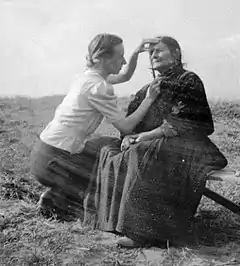
Eva Justin (23 August 1909 – 11 September 1966) was a German anthropologist who was active during the Nazi era. She specialised in scientific racism. Her work contributed to the Nazi crimes against the Sinti and Roma peoples.[1]
Early life

Born in Dresden in 1909, the daughter of a railroad official, Eva Justin served as an assistant to Nazi psychologist Robert Ritter.[2][3]
Justin originally trained as a nurse and received her doctorate in anthropology from the University of Berlin in 1943 despite not having followed the normal university procedure to do so.[3][4] Eugen Fischer mentored her through her doctoral thesis and final exams, and ethnologist Richard Thurnwald was a reviewer.[2] Justin was one of the early registered nurses to earn a PhD.[5] Speaking Romani, she earned the trust of Roma and Sinti people. Her doctoral dissertation was titled "Lebensschicksale artfremd erzogener Zigeunerkinder und ihrer Nachkommen" ("Biographical destinies of Gypsy children and their offspring who were educated in a manner inappropriate for their species").[2]
Holocaust
The children that Justin studied had been selected for deportation, but this was delayed until she completed her research and received her PhD. The children were later sent to the "Gypsy family camp" at Auschwitz on 6 May 1944.[2] Soon after their arrival, Josef Mengele arrived at Auschwitz. Some of the children were subjected to his experiments and most were eventually killed in the gas chamber. About 39 or 40 children that Justin had studied were sent to Auschwitz in 1944, and all but four died before the end of the war, many before her thesis was published.[note 1][6][7] Thirty-nine children from an orphanage in Mulfingen, who were the subjects of Justin's doctoral thesis, were registered at Auschwitz on 12 May 1944.[8] She searched for anthropological subjects in concentration camps.[9][10]
Justin was a senior member of the Race Hygiene Research Center.[11] She wrote in the foreword to a research paper that she hoped to provide the basis for further racial hygiene laws to stop the flow of "unworthy primitive elements" into the German population.[12] Her position was that Romani people could not be assimilated because "they usually became asocial as a result of their primitive thinking, and that attempts to educate them should be stopped."[13] Justin proposed sterilization for Romani people, except for those with "pure Gypsy blood."[14] She was present when the Sinti and Roma deportations to concentration camps were organized.[2]
In 1958, the Frankfurt district attorney initiated an investigation into Justin's wartime actions, but the investigation was closed in 1960,[15][note 2] after the district attorney had concluded that her actions were subject to the statute of limitations. Frankfurt magistrates found insufficient evidence to prosecute Justin in 1964, believing that Justin had not known her ideas would lead to the children being sent to concentration camps and that survivors could not specifically remember her striking them. Justin had based her work on the ideas of Robert Ritter and no longer believed them.[16]
In post-war West Germany, Justin worked as a psychologist for the Frankfurt police, even acting as a consultant to the legal system for compensation cases for Holocaust survivors.[17] She died from cancer in 1966 in Offenbach am Main, a city on the outskirts of Frankfurt.[18]
See also
Notes
References
- ↑ Barth, Fredrik (2005). One Discipline, Four Ways: British, German, French, and American Anthropology (1st ed.). University of Chicago Press. pp. 106, 122. ISBN 978-0226038292
- 1 2 3 4 5 6 7 Barth (2005), p. 122
- 1 2 Friedlander, Henry (1997). The Origins of Nazi Genocide: From Euthanasia to the Final Solution. University of North Carolina Press. p. 250. ISBN 978-0807846759
- ↑ Barth (2005), p. 121
- ↑ Benedict, Susan; Shields, Linda; Holmes, Colin; Kurth, Julia (1 January 2016). "A nurse working for the Third Reich: Eva Justin, RN, PhD". Journal of Medical Biography. 26 (4): 259–267. doi:10.1177/0967772016666684. PMID 28092480. S2CID 24375668
- ↑ Kenrick, Donald; Puxon, Grattan (2009). Gypsies Under the Swastika. University of Hertfordshire Press. p. 42. ISBN 978-1902806808
- ↑ "Medical biography; Studies from Medical University of South Carolina yield new information about medical biography (A nurse working for the Third Reich: Eva Justin, RN, PhD", Health & Medicine Week, p. 7415, 24 February 2017 – via ProQuest Central
- ↑ Friedlander (1997), p. 294
- ↑ Friedlander (1997), p. 134
- ↑ "Otto Rosenberg". The Times. London. 2 August 2001. p. 19 – via ProQuest Central
- ↑ Kenrick, Donald (2006). The Gypsies During the Second World War: The Final Chapter. University Of Hertfordshire Press. p. 141. ISBN 978-1-902806-49-5
- ↑ Kenrick & Puxon (2009), p. 18
- ↑ Kenrick & Puxon (2009), pp. 15, 18–19
- ↑ Kenrick (2006), p. xvi
- ↑ Kenrick (2006), p. 164
- ↑ Kenrick & Puxon (2009), p. 19
- ↑ Barth (2005), pp. 122–23
- ↑ Heberer, Patricai (2011). Children During the Holocaust. Rowman Altamira. p. 224. ISBN 978-0759119864.
Further reading
- A Century of Genocide: Critical Essays and Eyewitness Accounts By Samuel Totten, William S. Parsons Publisher: Routledge; 2 edition (2004) Language: English ISBN 978-0415944304
- Sinti and Roma: Gypsies in German-speaking society and literature By Susan Tebbutt Language: English ISBN 978-1571819215
- Auf Wiedersehen im Himmel: Die Geschichte der Angela Reinhardt (See You in Heaven: The Story of Angela Reinhardt). Publisher: Arena (2005) Language: German ISBN 3-401-02721-2 One of the children at St. Josephs who was escaped deportation and survived the war.
